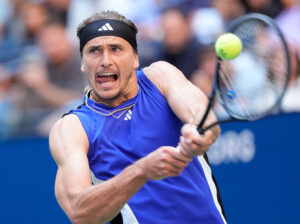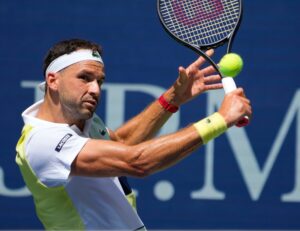Jannik Sinner has been rising steadily the last couple years, now sitting at #10 in the world, and the natural progression of his young career may see him contending for major titles this year. He is a pleasant mixture of power and precision, a rare all-court player in a power-tennis world. The blend of skills is impressive, especially at a young age, and his momentum suggests a continued rise that should see him well in the mix tournament after tournament.
A Balanced Game
Sinner’s game is a well-rounded game, yet it is not devoid of paradoxes. He often overpowers opponents, yet is one of the slimmest players on tour. He strikes the ball as cleanly and strongly as almost anyone, yet uses a racket so light that its static weight (325g) would be comfortable for many amateurs. He hits with relentless power forehand and backhand, and thrives in baseline rallies, yet moves to the net seamlessly and hits volleys and half-volleys with excellent touch. And he seems equally comfortable attacking and defending, and hits with about the same power from both wings. Some of this is seeming-paradox, some of it is just balance, but whatever it is, it leaves only small holes for opposing players to attack. Complete games like that become fixtures inside the Top 10.
Uncommon Mechanics
Sinner is one of the increasingly less-frequent players to hit his forehand from the elbow and wrist rather than the shoulder, a group that also includes Djokovic, Federer, and Rublev. Players hit with more power from the shoulder, though with less control, and since the power game is dominant these days, such players tend to rise. The elbow stroke is a quicker stroke, and therefore suited to faster surfaces, especially grass, but there aren’t many grass tournaments left. The longer motion of the shoulder stroke suits it better to clay, and hard courts sit somewhere in the middle.
Sinner’s control of the small muscle groups of the arm are what give him such good touch when he comes forward, a quality shared with the three mentioned above, (and with one of the ultimate touch players, Dustin Brown). On groundstrokes, the whipping motion generated by the elbow and wrist is best suited to creating pace off of slower balls. He can turn slices and junk balls into winners, where power-hitters sometimes struggle against junk because it doesn’t give them any pace to work with (see Nadal vs. Brown, Wimbledon 2015). Sinner handles pace well on the forehand, but he tends not to do as much with it in those situations, and the strain on his lower arm is evident; there is a looseness in the racket that is not there for players who swing from the shoulder. But give him time to set up on a ball, and he routinely crushes them into the corners.
The opposite dynamic is true of his backhand, which absorbs and redirects pace well. He hits the backhand quite hard, often with depth, and can put surprising pace on backhand groundstrokes even when he has little time to setup, and shortens his backswing. An opponent is left scratching their head about where to attack. Which side do you go to? He hits cleanly and powerfully from both wings. Baseline rallies, or bring him to net? It doesn’t seem to trouble him to do either. If you attack him, he defends well, and if you let him attack, he’s comfortable putting the ball away.
High Comparisons
Sinner doesn’t have an exact comparison in terms of his style, but the closest would be Djokovic and Rublev. The whipping elbow-and-wrist stroke is similar, and the powerful two-handed backhand is similar. They are all the same height, and are similar in build. They all play defense well on the baseline, and hit fairly aggressively (Rublev most of all), while also playing comfortably at the net. Sinner plays perpetually with a poker face, and is the most reserved in his interviews, but all three are of an intelligent and analytical personality type. And they are all currently close in the rankings.
I want to complain about Sinner’s physique (6’2”, 167 lbs.), and suggest that he put on a bit more muscle, but he is so close to Djokovic—who has made a career out of slim fitness—that I wouldn’t be able to take my own criticism too seriously. I’ll do the best I can, then, and suggest that he put on at least three pounds to get up to Djokovic’s 170. (These are the things you have to reach for when a player is as well-rounded as Sinner has become.) He could also use a more powerful serve, particularly his second, which would be an obvious effect of muscle gain; but even then, the same thing could be said of Djokovic, who doesn’t seem to have suffered from lack of power on the serve.
Good Form to Start AO ‘22
His match against Joao Sousa in the Australian Open first round was an example of his game at peak performance. Every ball was hit well. His forehand was a cleanly struck stroke of aggression, sent deep into the corners, hit at angles for winners, and frequently driving Sousa back behind the line. If Sousa tried to get away from the forehand barrage and hit to the backhand, he found himself still under assault, Sinner’s backhands hit perhaps even harder and deeper. Because the forehand is so dominant in modern tennis, opponents will sometimes try to put a player into the so-called “backhand cage”; but when the backhand is struck regularly with clean power, what do you do? Sinner also approached the net intelligently, and a couple times hit half-volleys that looked like they had come out of the playbook of the aforementioned Dustin Brown.
In the second round, Sinner was dialed back just a tad against Steve Johnson, but the result was another win in straight sets. He was able to stay away from Johnson’s big forehand (and got in trouble a few times when he didn’t), and had recourse to Johnson’s backhand side, which played weaker. Johnson didn’t have the same strategic luxury, and found himself down quickly and unable to recover, as Sinner rolled to victory in well under two hours.
[pickup_prop id=”18819″]
Sinner’s rise has been steady, and nothing suggests that he has reached the top yet. He’s so young that, even if he were to plateau for a while, people would still expect greater things in the future. And while the hype around him has not been the same as for some other young players (some of whom have panned out and others who have not), he is at the point of success and consistency where he should be considered a contender for major titles. The Big Three is now the Big Two, and Nadal looks mortal, while Djokovic is in a weird limbo at the moment; and the younger generation is knocking hard at the door. Sinner ascended when no one was looking for him, but at this point people should be looking, as he stands poised for regular contention in 2022. And that includes a January Slam with a wide-open field.
Main Photo from Getty Images






